Investigating the Impact of Mass Media and Technology on Youth Culture
VerifiedAdded on 2023/06/11
|11
|2812
|244
Report
AI Summary
This research proposal delves into the multifaceted impact of mass media on youth culture, examining the shifts in social norms, behaviors, and beliefs among young people due to technological advancements. It addresses key research questions concerning cultural changes, the role of technology as a catalyst for social change, and the challenges confronting modern youth. The proposal outlines a mixed-methods research design, incorporating both quantitative and qualitative data collection techniques to provide a comprehensive understanding of the subject. It considers ethical issues related to data collection and analysis, aiming to explore the influence of mass media, including both its positive and negative aspects, on the lives and experiences of adolescents in contemporary society. Desklib offers a platform to access similar research proposals and study resources.
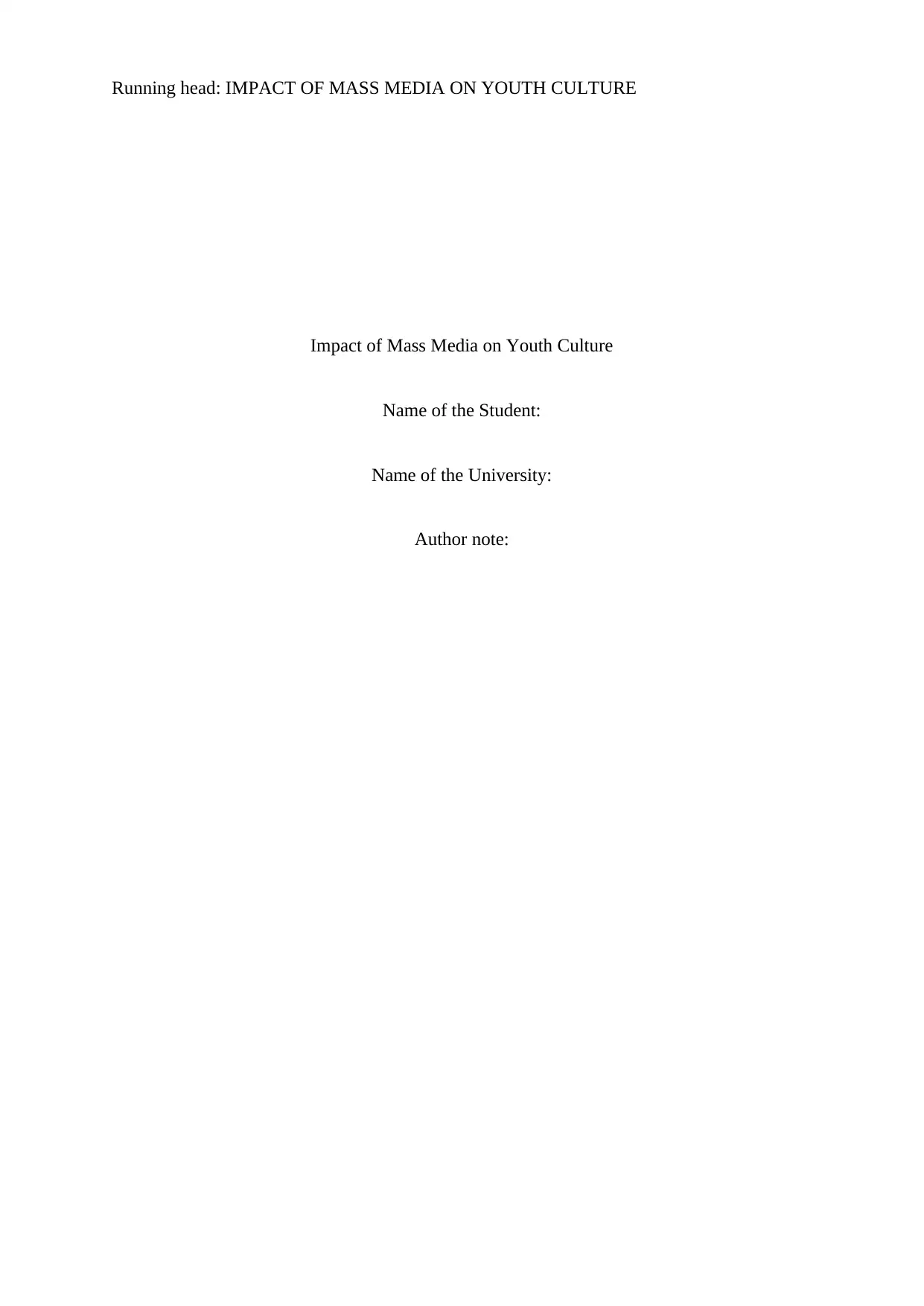
Running head: IMPACT OF MASS MEDIA ON YOUTH CULTURE
Impact of Mass Media on Youth Culture
Name of the Student:
Name of the University:
Author note:
Impact of Mass Media on Youth Culture
Name of the Student:
Name of the University:
Author note:
Paraphrase This Document
Need a fresh take? Get an instant paraphrase of this document with our AI Paraphraser
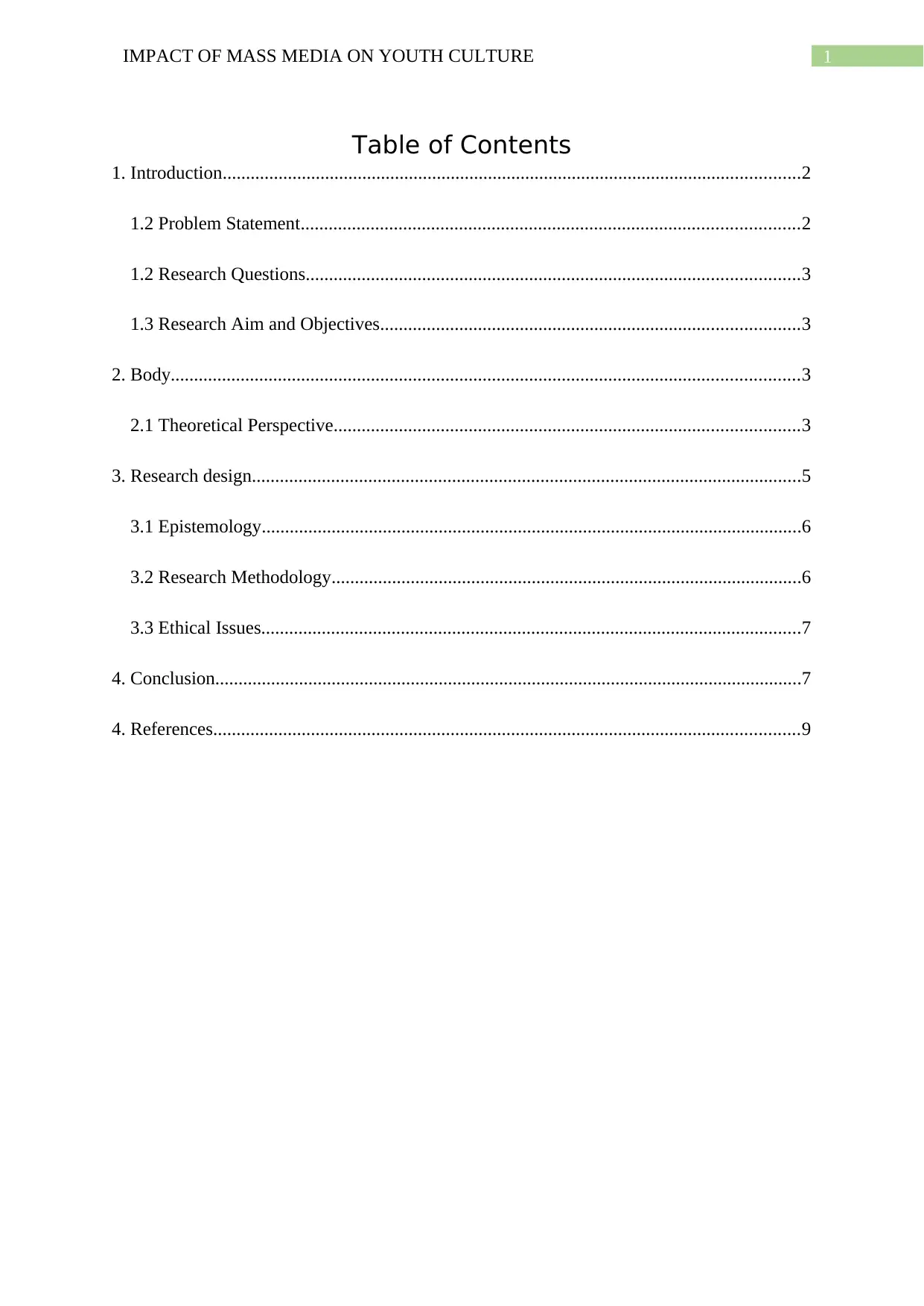
1IMPACT OF MASS MEDIA ON YOUTH CULTURE
Table of Contents
1. Introduction............................................................................................................................2
1.2 Problem Statement...........................................................................................................2
1.2 Research Questions..........................................................................................................3
1.3 Research Aim and Objectives..........................................................................................3
2. Body.......................................................................................................................................3
2.1 Theoretical Perspective....................................................................................................3
3. Research design......................................................................................................................5
3.1 Epistemology....................................................................................................................6
3.2 Research Methodology.....................................................................................................6
3.3 Ethical Issues....................................................................................................................7
4. Conclusion..............................................................................................................................7
4. References..............................................................................................................................9
Table of Contents
1. Introduction............................................................................................................................2
1.2 Problem Statement...........................................................................................................2
1.2 Research Questions..........................................................................................................3
1.3 Research Aim and Objectives..........................................................................................3
2. Body.......................................................................................................................................3
2.1 Theoretical Perspective....................................................................................................3
3. Research design......................................................................................................................5
3.1 Epistemology....................................................................................................................6
3.2 Research Methodology.....................................................................................................6
3.3 Ethical Issues....................................................................................................................7
4. Conclusion..............................................................................................................................7
4. References..............................................................................................................................9
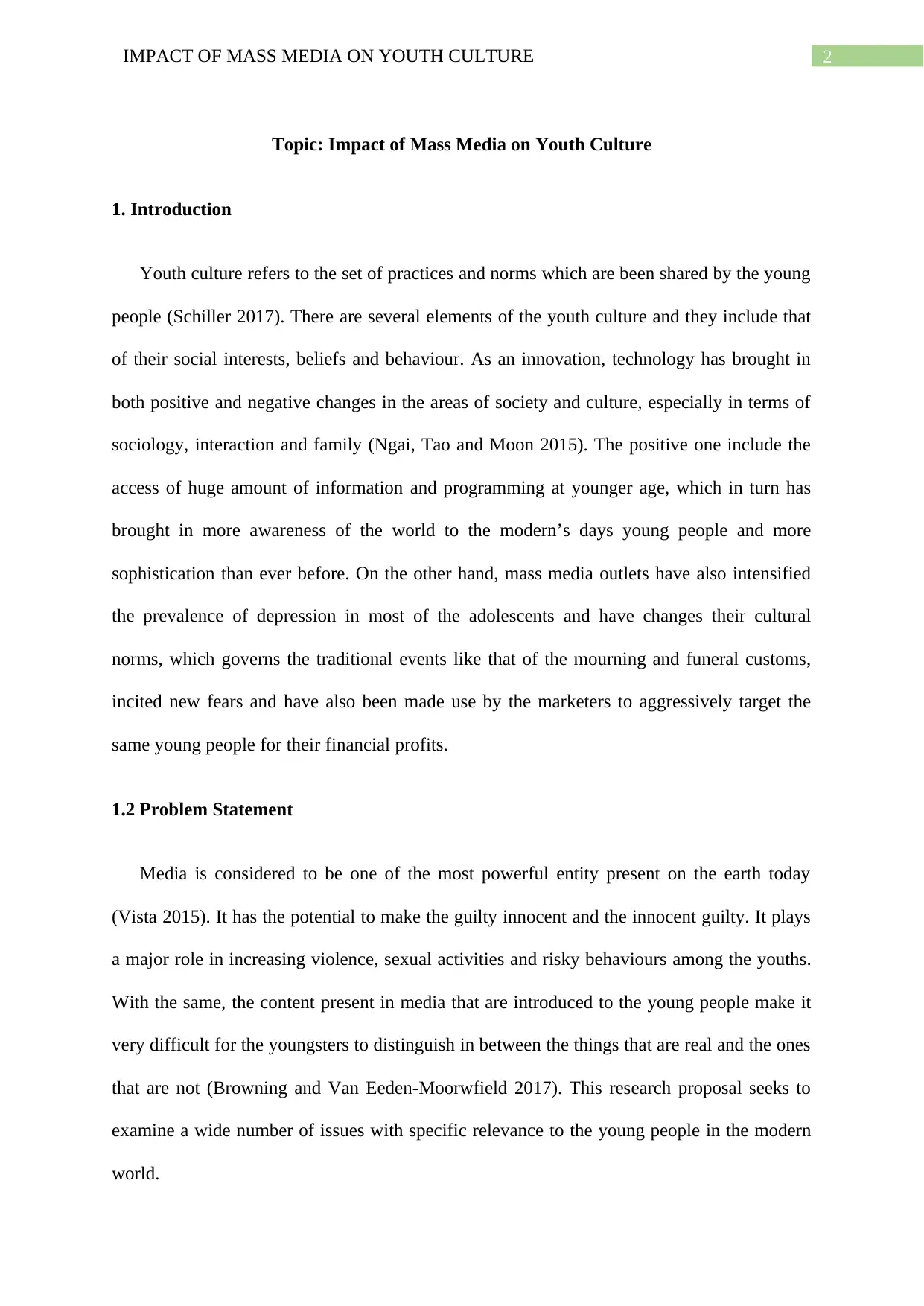
2IMPACT OF MASS MEDIA ON YOUTH CULTURE
Topic: Impact of Mass Media on Youth Culture
1. Introduction
Youth culture refers to the set of practices and norms which are been shared by the young
people (Schiller 2017). There are several elements of the youth culture and they include that
of their social interests, beliefs and behaviour. As an innovation, technology has brought in
both positive and negative changes in the areas of society and culture, especially in terms of
sociology, interaction and family (Ngai, Tao and Moon 2015). The positive one include the
access of huge amount of information and programming at younger age, which in turn has
brought in more awareness of the world to the modern’s days young people and more
sophistication than ever before. On the other hand, mass media outlets have also intensified
the prevalence of depression in most of the adolescents and have changes their cultural
norms, which governs the traditional events like that of the mourning and funeral customs,
incited new fears and have also been made use by the marketers to aggressively target the
same young people for their financial profits.
1.2 Problem Statement
Media is considered to be one of the most powerful entity present on the earth today
(Vista 2015). It has the potential to make the guilty innocent and the innocent guilty. It plays
a major role in increasing violence, sexual activities and risky behaviours among the youths.
With the same, the content present in media that are introduced to the young people make it
very difficult for the youngsters to distinguish in between the things that are real and the ones
that are not (Browning and Van Eeden-Moorwfield 2017). This research proposal seeks to
examine a wide number of issues with specific relevance to the young people in the modern
world.
Topic: Impact of Mass Media on Youth Culture
1. Introduction
Youth culture refers to the set of practices and norms which are been shared by the young
people (Schiller 2017). There are several elements of the youth culture and they include that
of their social interests, beliefs and behaviour. As an innovation, technology has brought in
both positive and negative changes in the areas of society and culture, especially in terms of
sociology, interaction and family (Ngai, Tao and Moon 2015). The positive one include the
access of huge amount of information and programming at younger age, which in turn has
brought in more awareness of the world to the modern’s days young people and more
sophistication than ever before. On the other hand, mass media outlets have also intensified
the prevalence of depression in most of the adolescents and have changes their cultural
norms, which governs the traditional events like that of the mourning and funeral customs,
incited new fears and have also been made use by the marketers to aggressively target the
same young people for their financial profits.
1.2 Problem Statement
Media is considered to be one of the most powerful entity present on the earth today
(Vista 2015). It has the potential to make the guilty innocent and the innocent guilty. It plays
a major role in increasing violence, sexual activities and risky behaviours among the youths.
With the same, the content present in media that are introduced to the young people make it
very difficult for the youngsters to distinguish in between the things that are real and the ones
that are not (Browning and Van Eeden-Moorwfield 2017). This research proposal seeks to
examine a wide number of issues with specific relevance to the young people in the modern
world.
⊘ This is a preview!⊘
Do you want full access?
Subscribe today to unlock all pages.

Trusted by 1+ million students worldwide
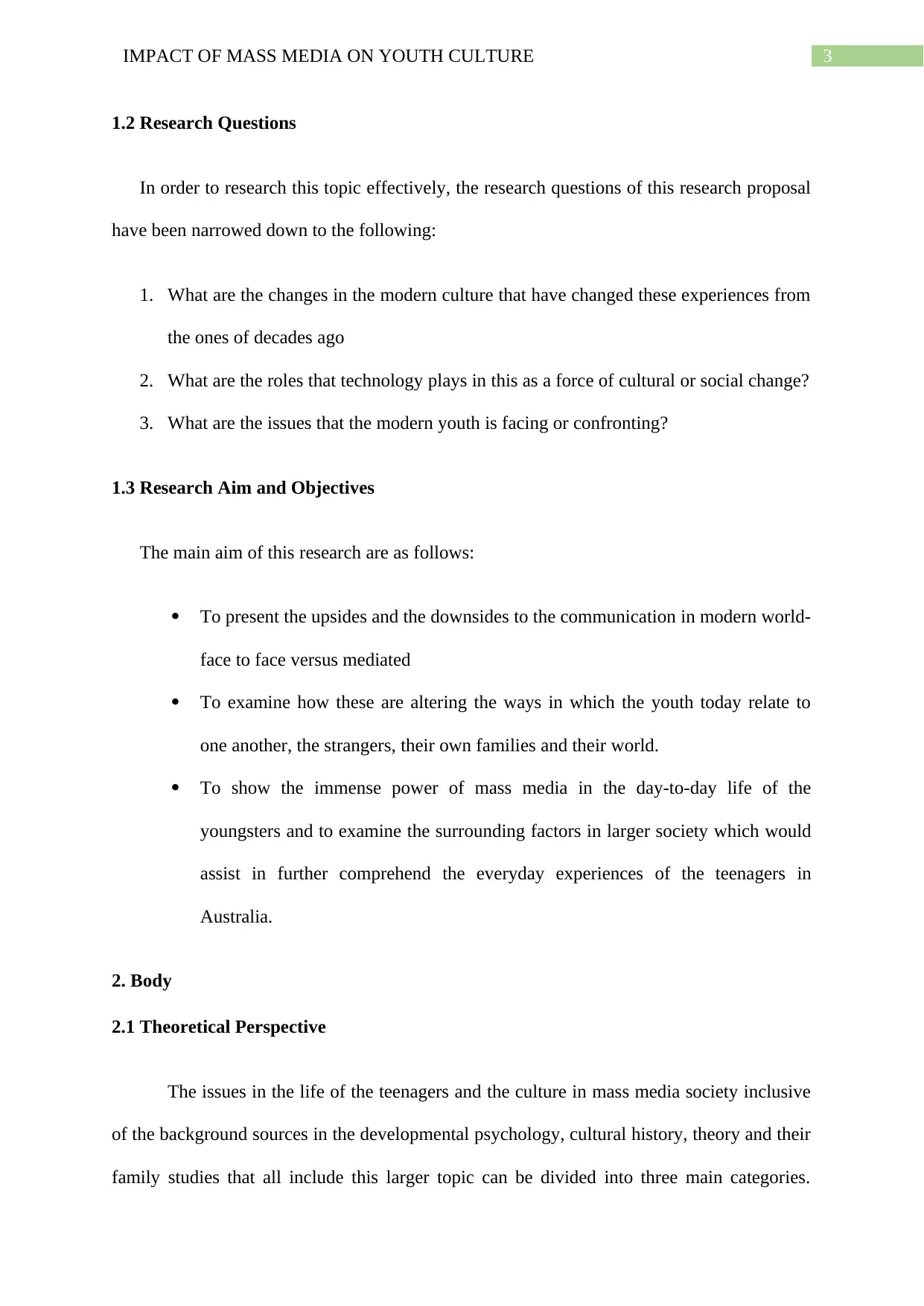
3IMPACT OF MASS MEDIA ON YOUTH CULTURE
1.2 Research Questions
In order to research this topic effectively, the research questions of this research proposal
have been narrowed down to the following:
1. What are the changes in the modern culture that have changed these experiences from
the ones of decades ago
2. What are the roles that technology plays in this as a force of cultural or social change?
3. What are the issues that the modern youth is facing or confronting?
1.3 Research Aim and Objectives
The main aim of this research are as follows:
To present the upsides and the downsides to the communication in modern world-
face to face versus mediated
To examine how these are altering the ways in which the youth today relate to
one another, the strangers, their own families and their world.
To show the immense power of mass media in the day-to-day life of the
youngsters and to examine the surrounding factors in larger society which would
assist in further comprehend the everyday experiences of the teenagers in
Australia.
2. Body
2.1 Theoretical Perspective
The issues in the life of the teenagers and the culture in mass media society inclusive
of the background sources in the developmental psychology, cultural history, theory and their
family studies that all include this larger topic can be divided into three main categories.
1.2 Research Questions
In order to research this topic effectively, the research questions of this research proposal
have been narrowed down to the following:
1. What are the changes in the modern culture that have changed these experiences from
the ones of decades ago
2. What are the roles that technology plays in this as a force of cultural or social change?
3. What are the issues that the modern youth is facing or confronting?
1.3 Research Aim and Objectives
The main aim of this research are as follows:
To present the upsides and the downsides to the communication in modern world-
face to face versus mediated
To examine how these are altering the ways in which the youth today relate to
one another, the strangers, their own families and their world.
To show the immense power of mass media in the day-to-day life of the
youngsters and to examine the surrounding factors in larger society which would
assist in further comprehend the everyday experiences of the teenagers in
Australia.
2. Body
2.1 Theoretical Perspective
The issues in the life of the teenagers and the culture in mass media society inclusive
of the background sources in the developmental psychology, cultural history, theory and their
family studies that all include this larger topic can be divided into three main categories.
Paraphrase This Document
Need a fresh take? Get an instant paraphrase of this document with our AI Paraphraser
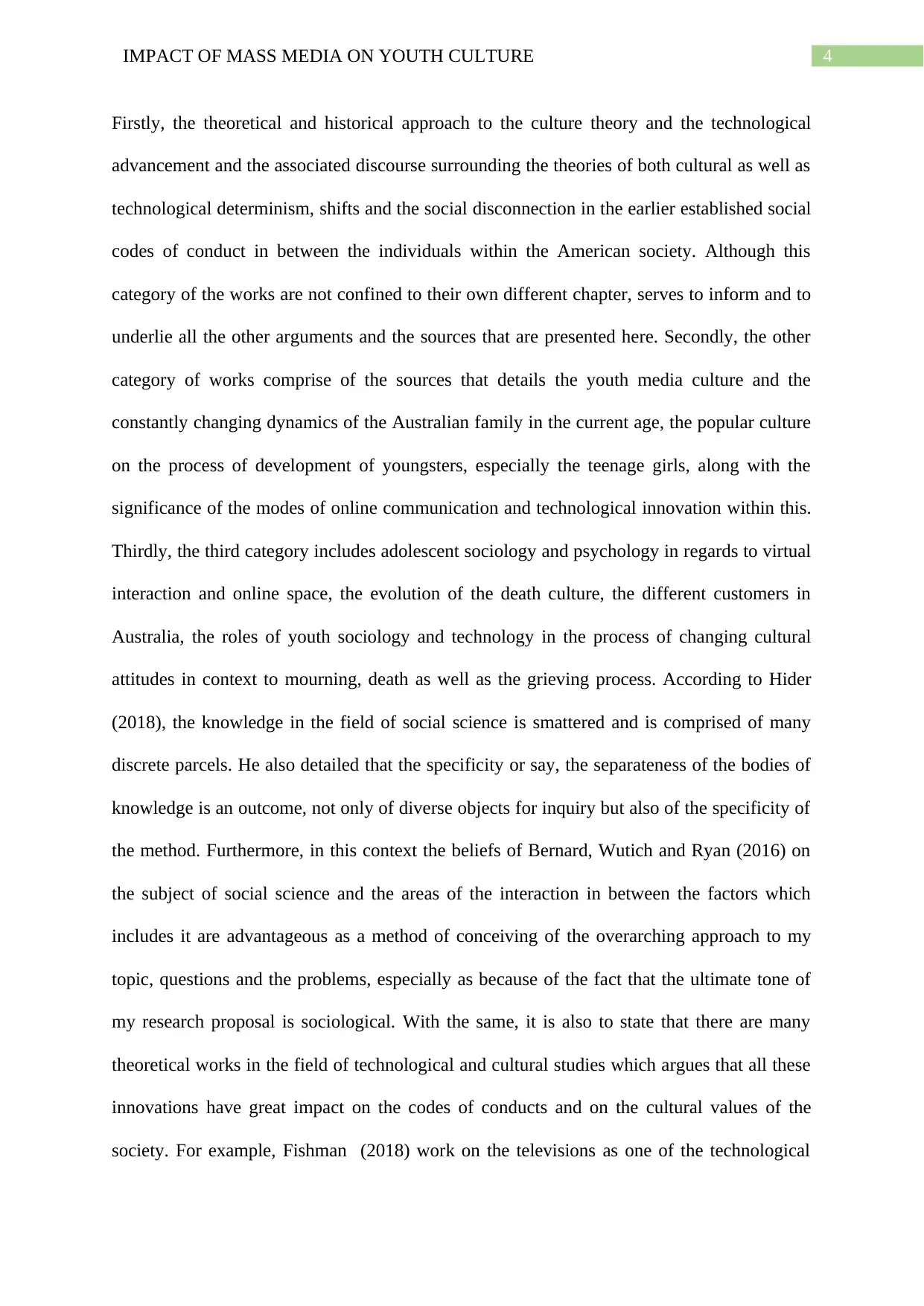
4IMPACT OF MASS MEDIA ON YOUTH CULTURE
Firstly, the theoretical and historical approach to the culture theory and the technological
advancement and the associated discourse surrounding the theories of both cultural as well as
technological determinism, shifts and the social disconnection in the earlier established social
codes of conduct in between the individuals within the American society. Although this
category of the works are not confined to their own different chapter, serves to inform and to
underlie all the other arguments and the sources that are presented here. Secondly, the other
category of works comprise of the sources that details the youth media culture and the
constantly changing dynamics of the Australian family in the current age, the popular culture
on the process of development of youngsters, especially the teenage girls, along with the
significance of the modes of online communication and technological innovation within this.
Thirdly, the third category includes adolescent sociology and psychology in regards to virtual
interaction and online space, the evolution of the death culture, the different customers in
Australia, the roles of youth sociology and technology in the process of changing cultural
attitudes in context to mourning, death as well as the grieving process. According to Hider
(2018), the knowledge in the field of social science is smattered and is comprised of many
discrete parcels. He also detailed that the specificity or say, the separateness of the bodies of
knowledge is an outcome, not only of diverse objects for inquiry but also of the specificity of
the method. Furthermore, in this context the beliefs of Bernard, Wutich and Ryan (2016) on
the subject of social science and the areas of the interaction in between the factors which
includes it are advantageous as a method of conceiving of the overarching approach to my
topic, questions and the problems, especially as because of the fact that the ultimate tone of
my research proposal is sociological. With the same, it is also to state that there are many
theoretical works in the field of technological and cultural studies which argues that all these
innovations have great impact on the codes of conducts and on the cultural values of the
society. For example, Fishman (2018) work on the televisions as one of the technological
Firstly, the theoretical and historical approach to the culture theory and the technological
advancement and the associated discourse surrounding the theories of both cultural as well as
technological determinism, shifts and the social disconnection in the earlier established social
codes of conduct in between the individuals within the American society. Although this
category of the works are not confined to their own different chapter, serves to inform and to
underlie all the other arguments and the sources that are presented here. Secondly, the other
category of works comprise of the sources that details the youth media culture and the
constantly changing dynamics of the Australian family in the current age, the popular culture
on the process of development of youngsters, especially the teenage girls, along with the
significance of the modes of online communication and technological innovation within this.
Thirdly, the third category includes adolescent sociology and psychology in regards to virtual
interaction and online space, the evolution of the death culture, the different customers in
Australia, the roles of youth sociology and technology in the process of changing cultural
attitudes in context to mourning, death as well as the grieving process. According to Hider
(2018), the knowledge in the field of social science is smattered and is comprised of many
discrete parcels. He also detailed that the specificity or say, the separateness of the bodies of
knowledge is an outcome, not only of diverse objects for inquiry but also of the specificity of
the method. Furthermore, in this context the beliefs of Bernard, Wutich and Ryan (2016) on
the subject of social science and the areas of the interaction in between the factors which
includes it are advantageous as a method of conceiving of the overarching approach to my
topic, questions and the problems, especially as because of the fact that the ultimate tone of
my research proposal is sociological. With the same, it is also to state that there are many
theoretical works in the field of technological and cultural studies which argues that all these
innovations have great impact on the codes of conducts and on the cultural values of the
society. For example, Fishman (2018) work on the televisions as one of the technological
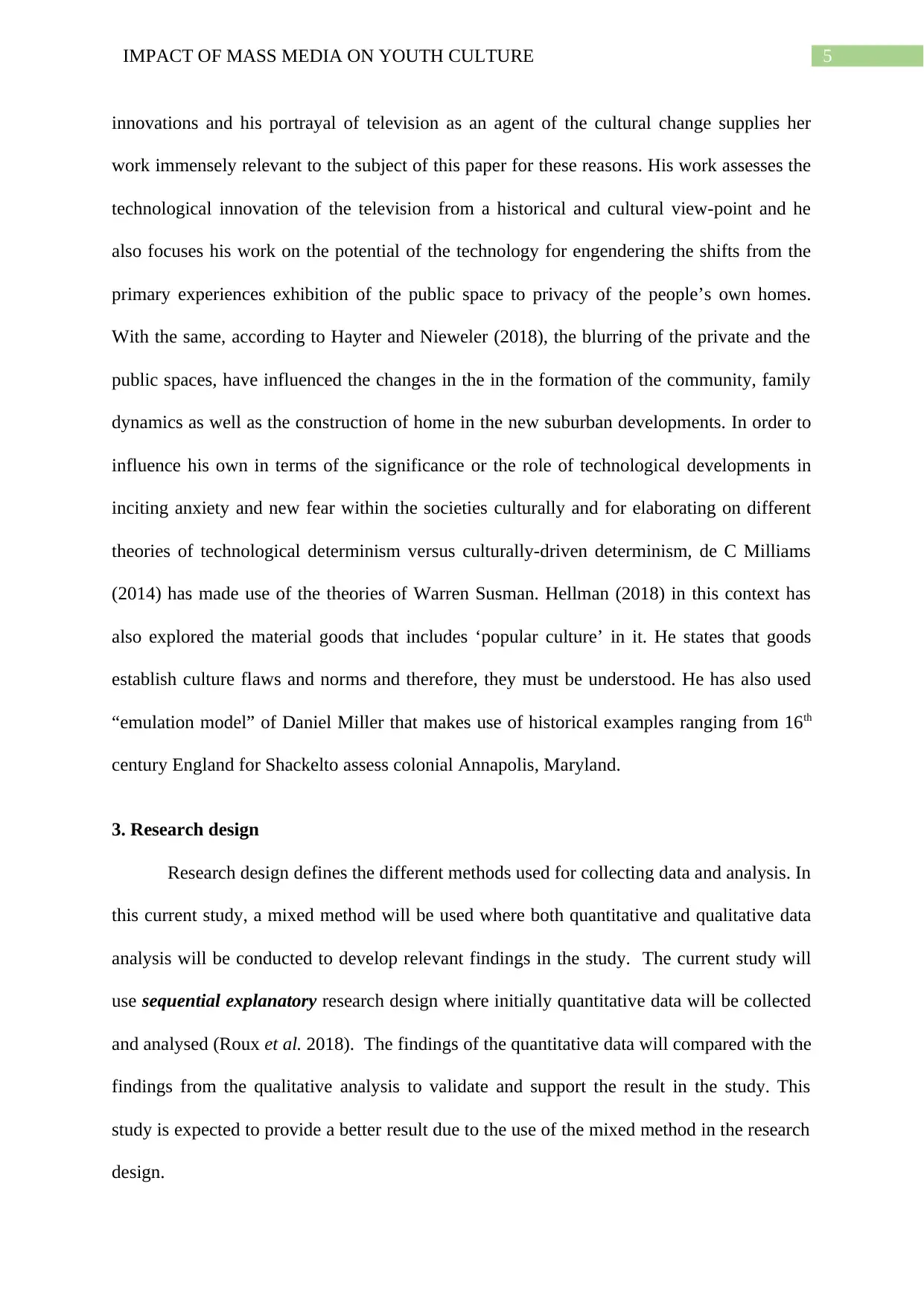
5IMPACT OF MASS MEDIA ON YOUTH CULTURE
innovations and his portrayal of television as an agent of the cultural change supplies her
work immensely relevant to the subject of this paper for these reasons. His work assesses the
technological innovation of the television from a historical and cultural view-point and he
also focuses his work on the potential of the technology for engendering the shifts from the
primary experiences exhibition of the public space to privacy of the people’s own homes.
With the same, according to Hayter and Nieweler (2018), the blurring of the private and the
public spaces, have influenced the changes in the in the formation of the community, family
dynamics as well as the construction of home in the new suburban developments. In order to
influence his own in terms of the significance or the role of technological developments in
inciting anxiety and new fear within the societies culturally and for elaborating on different
theories of technological determinism versus culturally-driven determinism, de C Milliams
(2014) has made use of the theories of Warren Susman. Hellman (2018) in this context has
also explored the material goods that includes ‘popular culture’ in it. He states that goods
establish culture flaws and norms and therefore, they must be understood. He has also used
“emulation model” of Daniel Miller that makes use of historical examples ranging from 16th
century England for Shackelto assess colonial Annapolis, Maryland.
3. Research design
Research design defines the different methods used for collecting data and analysis. In
this current study, a mixed method will be used where both quantitative and qualitative data
analysis will be conducted to develop relevant findings in the study. The current study will
use sequential explanatory research design where initially quantitative data will be collected
and analysed (Roux et al. 2018). The findings of the quantitative data will compared with the
findings from the qualitative analysis to validate and support the result in the study. This
study is expected to provide a better result due to the use of the mixed method in the research
design.
innovations and his portrayal of television as an agent of the cultural change supplies her
work immensely relevant to the subject of this paper for these reasons. His work assesses the
technological innovation of the television from a historical and cultural view-point and he
also focuses his work on the potential of the technology for engendering the shifts from the
primary experiences exhibition of the public space to privacy of the people’s own homes.
With the same, according to Hayter and Nieweler (2018), the blurring of the private and the
public spaces, have influenced the changes in the in the formation of the community, family
dynamics as well as the construction of home in the new suburban developments. In order to
influence his own in terms of the significance or the role of technological developments in
inciting anxiety and new fear within the societies culturally and for elaborating on different
theories of technological determinism versus culturally-driven determinism, de C Milliams
(2014) has made use of the theories of Warren Susman. Hellman (2018) in this context has
also explored the material goods that includes ‘popular culture’ in it. He states that goods
establish culture flaws and norms and therefore, they must be understood. He has also used
“emulation model” of Daniel Miller that makes use of historical examples ranging from 16th
century England for Shackelto assess colonial Annapolis, Maryland.
3. Research design
Research design defines the different methods used for collecting data and analysis. In
this current study, a mixed method will be used where both quantitative and qualitative data
analysis will be conducted to develop relevant findings in the study. The current study will
use sequential explanatory research design where initially quantitative data will be collected
and analysed (Roux et al. 2018). The findings of the quantitative data will compared with the
findings from the qualitative analysis to validate and support the result in the study. This
study is expected to provide a better result due to the use of the mixed method in the research
design.
⊘ This is a preview!⊘
Do you want full access?
Subscribe today to unlock all pages.

Trusted by 1+ million students worldwide
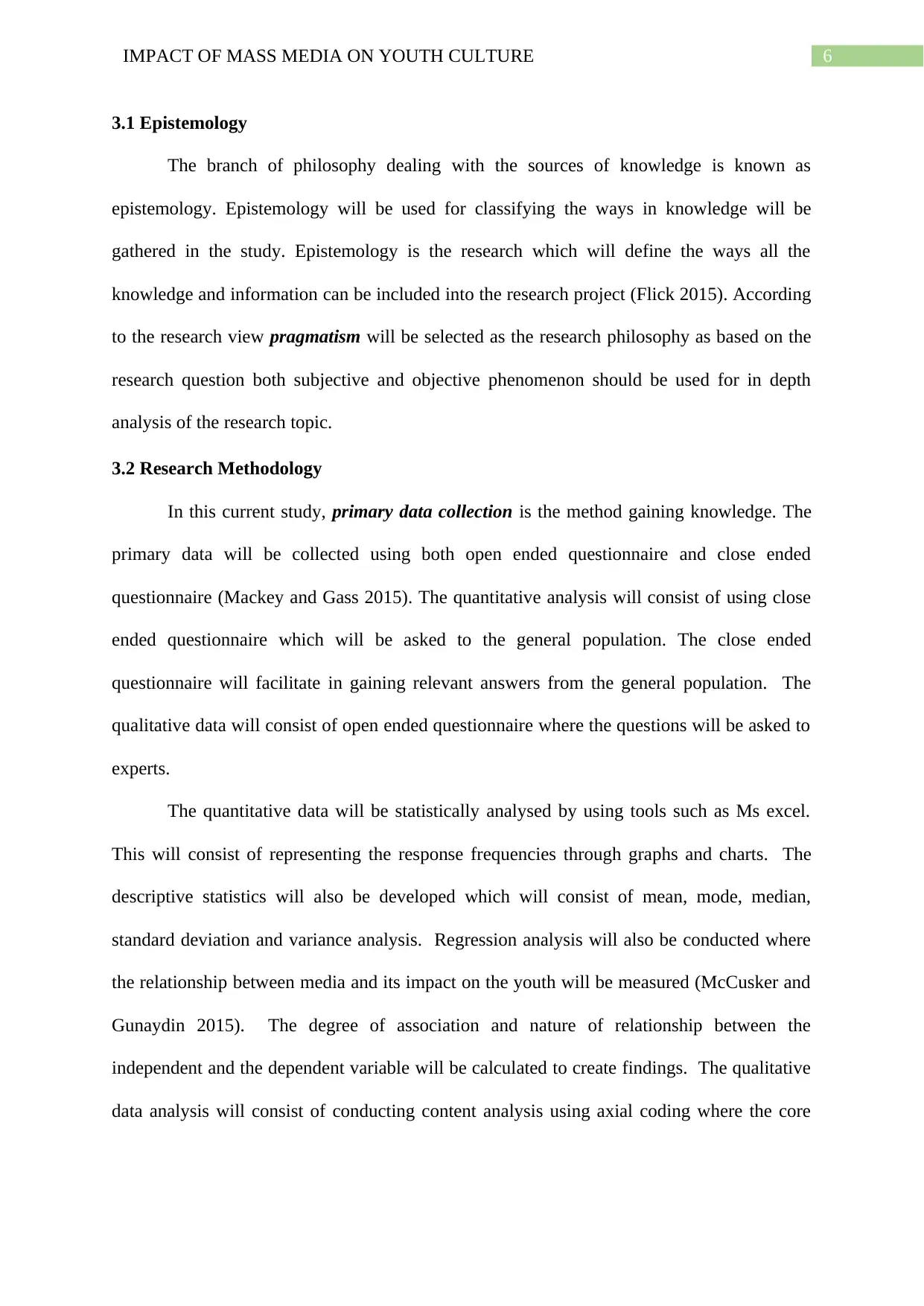
6IMPACT OF MASS MEDIA ON YOUTH CULTURE
3.1 Epistemology
The branch of philosophy dealing with the sources of knowledge is known as
epistemology. Epistemology will be used for classifying the ways in knowledge will be
gathered in the study. Epistemology is the research which will define the ways all the
knowledge and information can be included into the research project (Flick 2015). According
to the research view pragmatism will be selected as the research philosophy as based on the
research question both subjective and objective phenomenon should be used for in depth
analysis of the research topic.
3.2 Research Methodology
In this current study, primary data collection is the method gaining knowledge. The
primary data will be collected using both open ended questionnaire and close ended
questionnaire (Mackey and Gass 2015). The quantitative analysis will consist of using close
ended questionnaire which will be asked to the general population. The close ended
questionnaire will facilitate in gaining relevant answers from the general population. The
qualitative data will consist of open ended questionnaire where the questions will be asked to
experts.
The quantitative data will be statistically analysed by using tools such as Ms excel.
This will consist of representing the response frequencies through graphs and charts. The
descriptive statistics will also be developed which will consist of mean, mode, median,
standard deviation and variance analysis. Regression analysis will also be conducted where
the relationship between media and its impact on the youth will be measured (McCusker and
Gunaydin 2015). The degree of association and nature of relationship between the
independent and the dependent variable will be calculated to create findings. The qualitative
data analysis will consist of conducting content analysis using axial coding where the core
3.1 Epistemology
The branch of philosophy dealing with the sources of knowledge is known as
epistemology. Epistemology will be used for classifying the ways in knowledge will be
gathered in the study. Epistemology is the research which will define the ways all the
knowledge and information can be included into the research project (Flick 2015). According
to the research view pragmatism will be selected as the research philosophy as based on the
research question both subjective and objective phenomenon should be used for in depth
analysis of the research topic.
3.2 Research Methodology
In this current study, primary data collection is the method gaining knowledge. The
primary data will be collected using both open ended questionnaire and close ended
questionnaire (Mackey and Gass 2015). The quantitative analysis will consist of using close
ended questionnaire which will be asked to the general population. The close ended
questionnaire will facilitate in gaining relevant answers from the general population. The
qualitative data will consist of open ended questionnaire where the questions will be asked to
experts.
The quantitative data will be statistically analysed by using tools such as Ms excel.
This will consist of representing the response frequencies through graphs and charts. The
descriptive statistics will also be developed which will consist of mean, mode, median,
standard deviation and variance analysis. Regression analysis will also be conducted where
the relationship between media and its impact on the youth will be measured (McCusker and
Gunaydin 2015). The degree of association and nature of relationship between the
independent and the dependent variable will be calculated to create findings. The qualitative
data analysis will consist of conducting content analysis using axial coding where the core
Paraphrase This Document
Need a fresh take? Get an instant paraphrase of this document with our AI Paraphraser
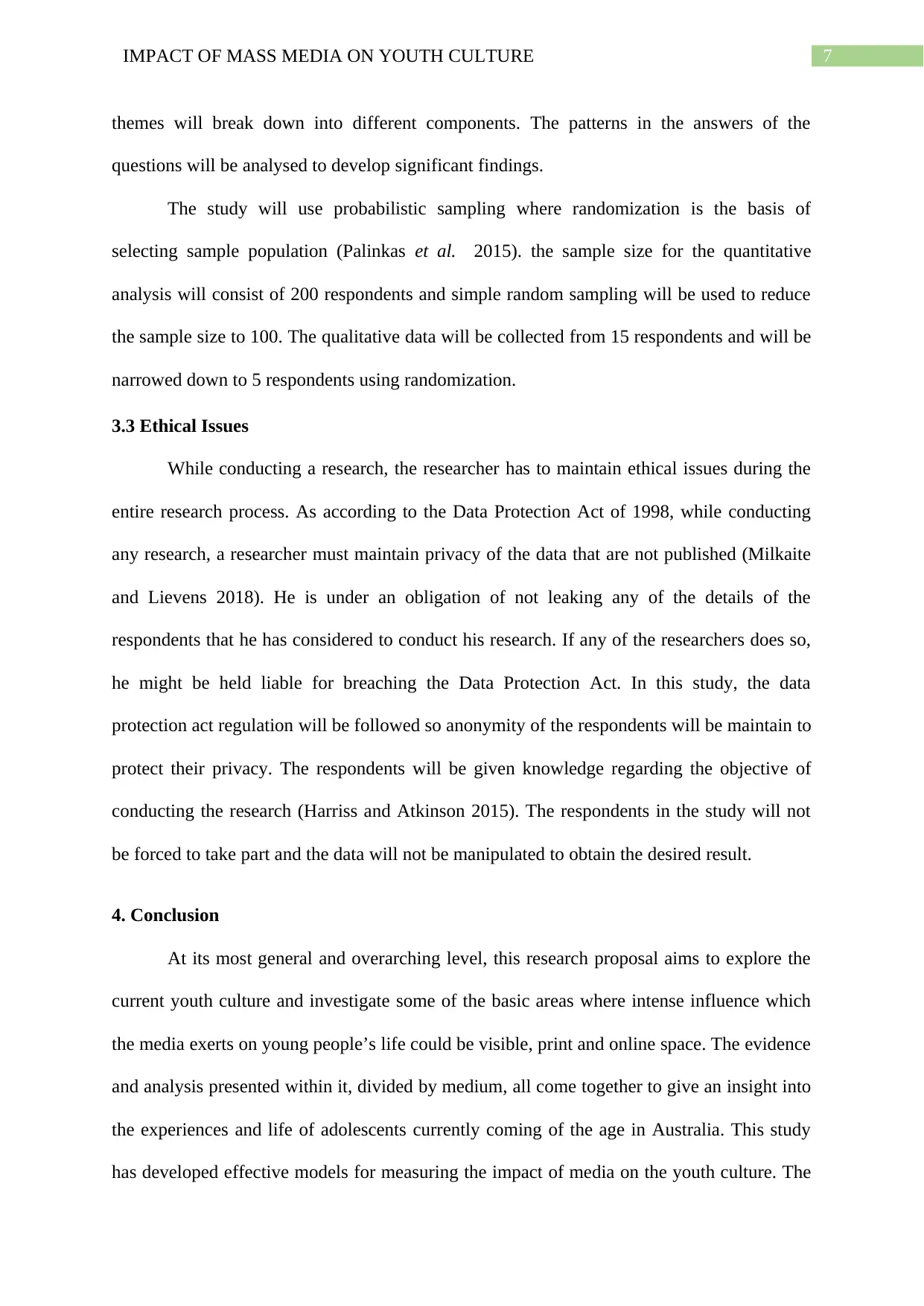
7IMPACT OF MASS MEDIA ON YOUTH CULTURE
themes will break down into different components. The patterns in the answers of the
questions will be analysed to develop significant findings.
The study will use probabilistic sampling where randomization is the basis of
selecting sample population (Palinkas et al. 2015). the sample size for the quantitative
analysis will consist of 200 respondents and simple random sampling will be used to reduce
the sample size to 100. The qualitative data will be collected from 15 respondents and will be
narrowed down to 5 respondents using randomization.
3.3 Ethical Issues
While conducting a research, the researcher has to maintain ethical issues during the
entire research process. As according to the Data Protection Act of 1998, while conducting
any research, a researcher must maintain privacy of the data that are not published (Milkaite
and Lievens 2018). He is under an obligation of not leaking any of the details of the
respondents that he has considered to conduct his research. If any of the researchers does so,
he might be held liable for breaching the Data Protection Act. In this study, the data
protection act regulation will be followed so anonymity of the respondents will be maintain to
protect their privacy. The respondents will be given knowledge regarding the objective of
conducting the research (Harriss and Atkinson 2015). The respondents in the study will not
be forced to take part and the data will not be manipulated to obtain the desired result.
4. Conclusion
At its most general and overarching level, this research proposal aims to explore the
current youth culture and investigate some of the basic areas where intense influence which
the media exerts on young people’s life could be visible, print and online space. The evidence
and analysis presented within it, divided by medium, all come together to give an insight into
the experiences and life of adolescents currently coming of the age in Australia. This study
has developed effective models for measuring the impact of media on the youth culture. The
themes will break down into different components. The patterns in the answers of the
questions will be analysed to develop significant findings.
The study will use probabilistic sampling where randomization is the basis of
selecting sample population (Palinkas et al. 2015). the sample size for the quantitative
analysis will consist of 200 respondents and simple random sampling will be used to reduce
the sample size to 100. The qualitative data will be collected from 15 respondents and will be
narrowed down to 5 respondents using randomization.
3.3 Ethical Issues
While conducting a research, the researcher has to maintain ethical issues during the
entire research process. As according to the Data Protection Act of 1998, while conducting
any research, a researcher must maintain privacy of the data that are not published (Milkaite
and Lievens 2018). He is under an obligation of not leaking any of the details of the
respondents that he has considered to conduct his research. If any of the researchers does so,
he might be held liable for breaching the Data Protection Act. In this study, the data
protection act regulation will be followed so anonymity of the respondents will be maintain to
protect their privacy. The respondents will be given knowledge regarding the objective of
conducting the research (Harriss and Atkinson 2015). The respondents in the study will not
be forced to take part and the data will not be manipulated to obtain the desired result.
4. Conclusion
At its most general and overarching level, this research proposal aims to explore the
current youth culture and investigate some of the basic areas where intense influence which
the media exerts on young people’s life could be visible, print and online space. The evidence
and analysis presented within it, divided by medium, all come together to give an insight into
the experiences and life of adolescents currently coming of the age in Australia. This study
has developed effective models for measuring the impact of media on the youth culture. The
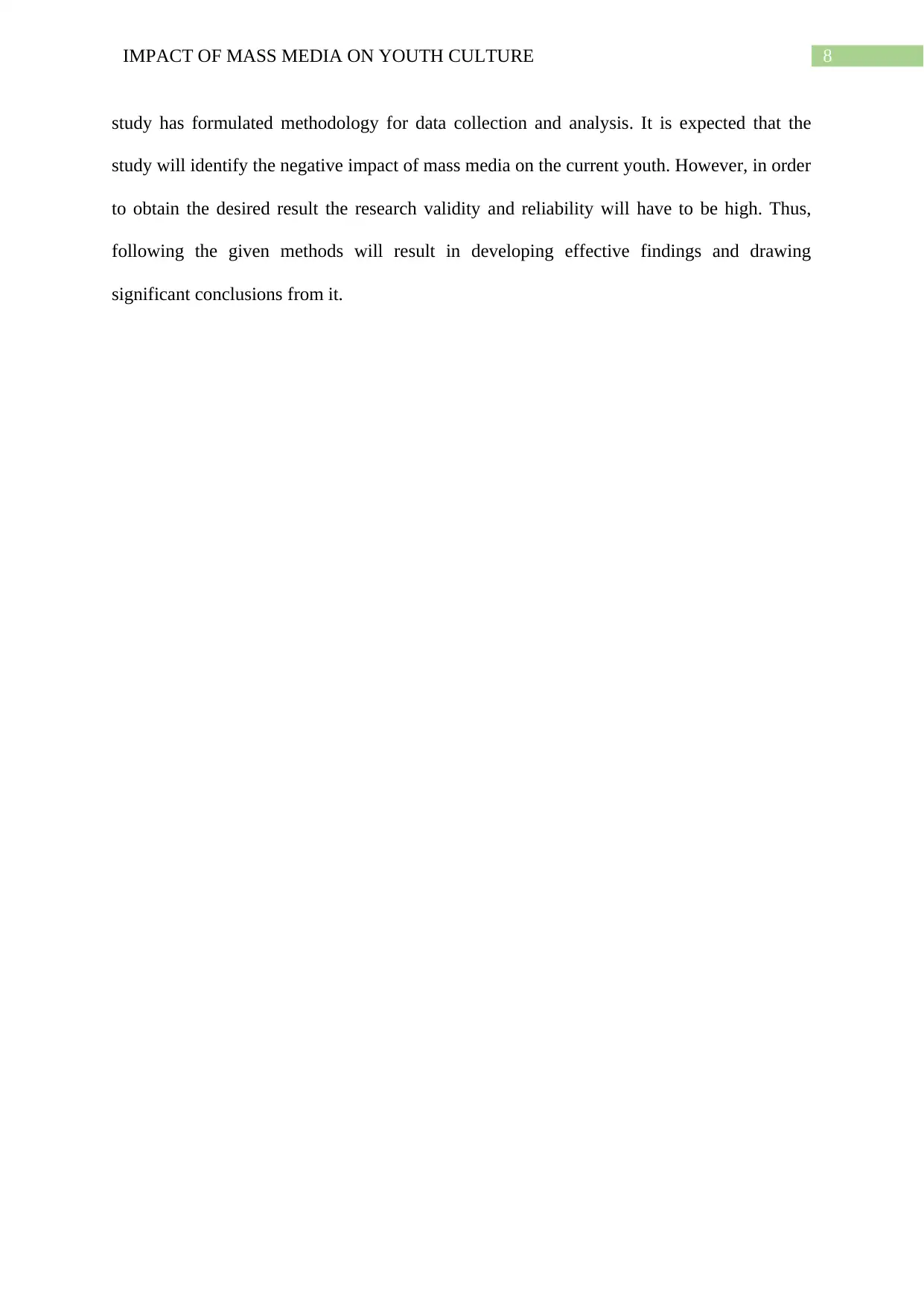
8IMPACT OF MASS MEDIA ON YOUTH CULTURE
study has formulated methodology for data collection and analysis. It is expected that the
study will identify the negative impact of mass media on the current youth. However, in order
to obtain the desired result the research validity and reliability will have to be high. Thus,
following the given methods will result in developing effective findings and drawing
significant conclusions from it.
study has formulated methodology for data collection and analysis. It is expected that the
study will identify the negative impact of mass media on the current youth. However, in order
to obtain the desired result the research validity and reliability will have to be high. Thus,
following the given methods will result in developing effective findings and drawing
significant conclusions from it.
⊘ This is a preview!⊘
Do you want full access?
Subscribe today to unlock all pages.

Trusted by 1+ million students worldwide
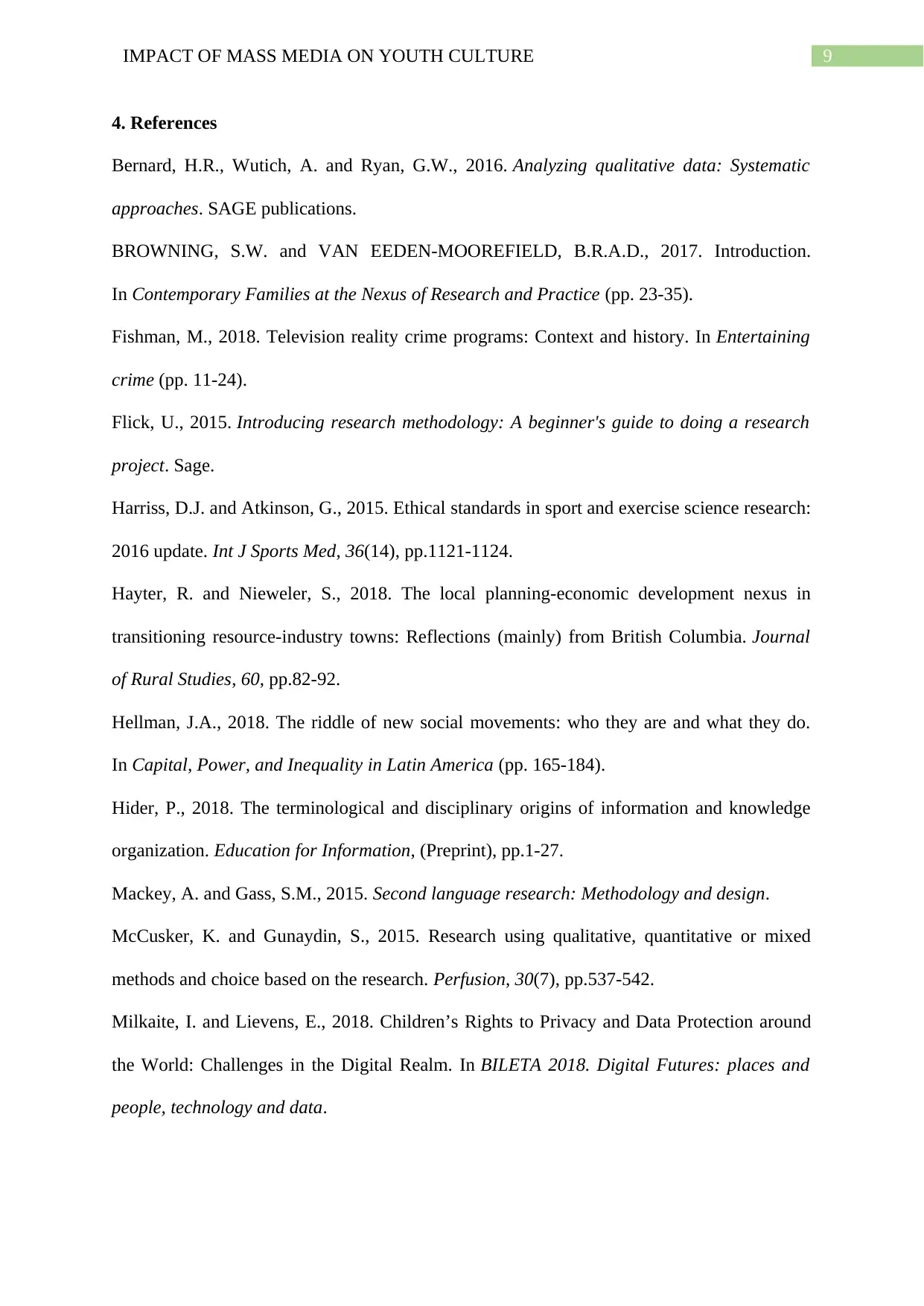
9IMPACT OF MASS MEDIA ON YOUTH CULTURE
4. References
Bernard, H.R., Wutich, A. and Ryan, G.W., 2016. Analyzing qualitative data: Systematic
approaches. SAGE publications.
BROWNING, S.W. and VAN EEDEN-MOOREFIELD, B.R.A.D., 2017. Introduction.
In Contemporary Families at the Nexus of Research and Practice (pp. 23-35).
Fishman, M., 2018. Television reality crime programs: Context and history. In Entertaining
crime (pp. 11-24).
Flick, U., 2015. Introducing research methodology: A beginner's guide to doing a research
project. Sage.
Harriss, D.J. and Atkinson, G., 2015. Ethical standards in sport and exercise science research:
2016 update. Int J Sports Med, 36(14), pp.1121-1124.
Hayter, R. and Nieweler, S., 2018. The local planning-economic development nexus in
transitioning resource-industry towns: Reflections (mainly) from British Columbia. Journal
of Rural Studies, 60, pp.82-92.
Hellman, J.A., 2018. The riddle of new social movements: who they are and what they do.
In Capital, Power, and Inequality in Latin America (pp. 165-184).
Hider, P., 2018. The terminological and disciplinary origins of information and knowledge
organization. Education for Information, (Preprint), pp.1-27.
Mackey, A. and Gass, S.M., 2015. Second language research: Methodology and design.
McCusker, K. and Gunaydin, S., 2015. Research using qualitative, quantitative or mixed
methods and choice based on the research. Perfusion, 30(7), pp.537-542.
Milkaite, I. and Lievens, E., 2018. Children’s Rights to Privacy and Data Protection around
the World: Challenges in the Digital Realm. In BILETA 2018. Digital Futures: places and
people, technology and data.
4. References
Bernard, H.R., Wutich, A. and Ryan, G.W., 2016. Analyzing qualitative data: Systematic
approaches. SAGE publications.
BROWNING, S.W. and VAN EEDEN-MOOREFIELD, B.R.A.D., 2017. Introduction.
In Contemporary Families at the Nexus of Research and Practice (pp. 23-35).
Fishman, M., 2018. Television reality crime programs: Context and history. In Entertaining
crime (pp. 11-24).
Flick, U., 2015. Introducing research methodology: A beginner's guide to doing a research
project. Sage.
Harriss, D.J. and Atkinson, G., 2015. Ethical standards in sport and exercise science research:
2016 update. Int J Sports Med, 36(14), pp.1121-1124.
Hayter, R. and Nieweler, S., 2018. The local planning-economic development nexus in
transitioning resource-industry towns: Reflections (mainly) from British Columbia. Journal
of Rural Studies, 60, pp.82-92.
Hellman, J.A., 2018. The riddle of new social movements: who they are and what they do.
In Capital, Power, and Inequality in Latin America (pp. 165-184).
Hider, P., 2018. The terminological and disciplinary origins of information and knowledge
organization. Education for Information, (Preprint), pp.1-27.
Mackey, A. and Gass, S.M., 2015. Second language research: Methodology and design.
McCusker, K. and Gunaydin, S., 2015. Research using qualitative, quantitative or mixed
methods and choice based on the research. Perfusion, 30(7), pp.537-542.
Milkaite, I. and Lievens, E., 2018. Children’s Rights to Privacy and Data Protection around
the World: Challenges in the Digital Realm. In BILETA 2018. Digital Futures: places and
people, technology and data.
Paraphrase This Document
Need a fresh take? Get an instant paraphrase of this document with our AI Paraphraser
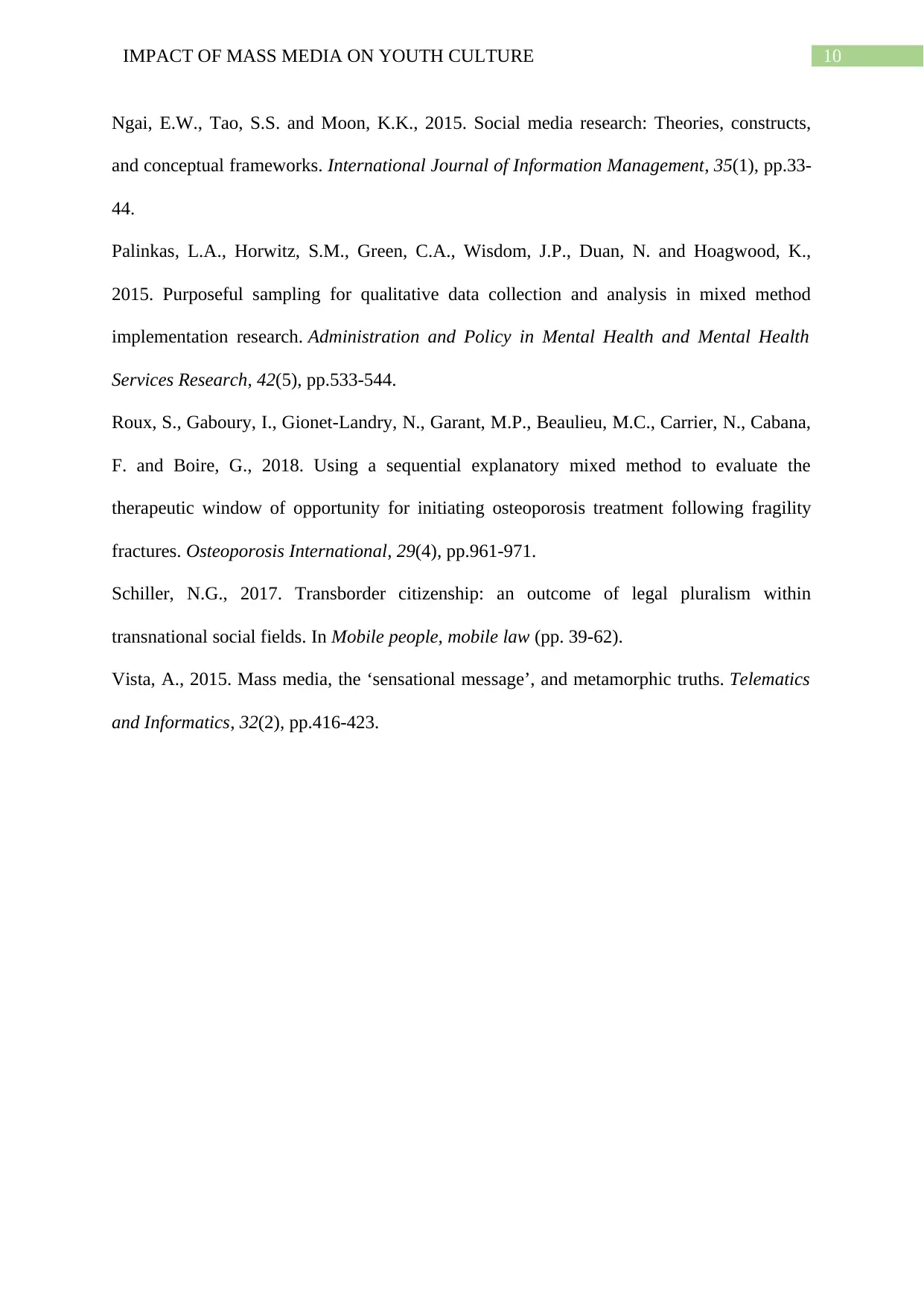
10IMPACT OF MASS MEDIA ON YOUTH CULTURE
Ngai, E.W., Tao, S.S. and Moon, K.K., 2015. Social media research: Theories, constructs,
and conceptual frameworks. International Journal of Information Management, 35(1), pp.33-
44.
Palinkas, L.A., Horwitz, S.M., Green, C.A., Wisdom, J.P., Duan, N. and Hoagwood, K.,
2015. Purposeful sampling for qualitative data collection and analysis in mixed method
implementation research. Administration and Policy in Mental Health and Mental Health
Services Research, 42(5), pp.533-544.
Roux, S., Gaboury, I., Gionet-Landry, N., Garant, M.P., Beaulieu, M.C., Carrier, N., Cabana,
F. and Boire, G., 2018. Using a sequential explanatory mixed method to evaluate the
therapeutic window of opportunity for initiating osteoporosis treatment following fragility
fractures. Osteoporosis International, 29(4), pp.961-971.
Schiller, N.G., 2017. Transborder citizenship: an outcome of legal pluralism within
transnational social fields. In Mobile people, mobile law (pp. 39-62).
Vista, A., 2015. Mass media, the ‘sensational message’, and metamorphic truths. Telematics
and Informatics, 32(2), pp.416-423.
Ngai, E.W., Tao, S.S. and Moon, K.K., 2015. Social media research: Theories, constructs,
and conceptual frameworks. International Journal of Information Management, 35(1), pp.33-
44.
Palinkas, L.A., Horwitz, S.M., Green, C.A., Wisdom, J.P., Duan, N. and Hoagwood, K.,
2015. Purposeful sampling for qualitative data collection and analysis in mixed method
implementation research. Administration and Policy in Mental Health and Mental Health
Services Research, 42(5), pp.533-544.
Roux, S., Gaboury, I., Gionet-Landry, N., Garant, M.P., Beaulieu, M.C., Carrier, N., Cabana,
F. and Boire, G., 2018. Using a sequential explanatory mixed method to evaluate the
therapeutic window of opportunity for initiating osteoporosis treatment following fragility
fractures. Osteoporosis International, 29(4), pp.961-971.
Schiller, N.G., 2017. Transborder citizenship: an outcome of legal pluralism within
transnational social fields. In Mobile people, mobile law (pp. 39-62).
Vista, A., 2015. Mass media, the ‘sensational message’, and metamorphic truths. Telematics
and Informatics, 32(2), pp.416-423.
1 out of 11
Related Documents
Your All-in-One AI-Powered Toolkit for Academic Success.
+13062052269
info@desklib.com
Available 24*7 on WhatsApp / Email
![[object Object]](/_next/static/media/star-bottom.7253800d.svg)
Unlock your academic potential
Copyright © 2020–2025 A2Z Services. All Rights Reserved. Developed and managed by ZUCOL.




